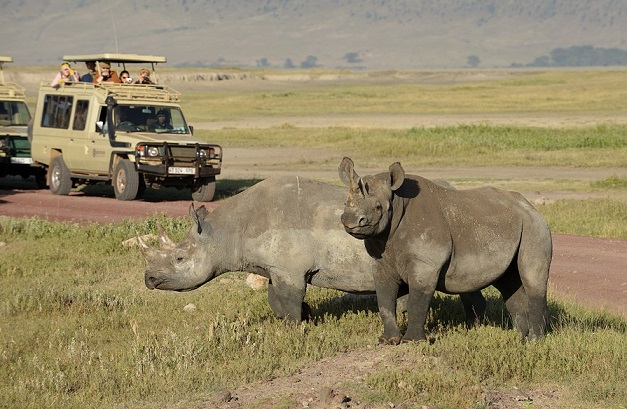- Ten rhinos will be marked in the conservation area by this month.
- The number of rhinos living inside the Ngorongoro Crater has grown to 71, among them 22 males and 49 females.
- All rhinos living in Tanzania will be marked with identifying numbers preceded by letter “U” to differentiate them with those in neighboring Kenya, being marked with identifying letter “V” preceding an individual animal’s number.
The official numbers designated for the rhinos in Ngorongoro in Tanzania start from 161 to 260, conservation officials said.

Identification tags on the rhinos’ left and right earlobes will be placed, while 4 of the male mammals will be fixed with devices for radio monitoring to monitor their movements while venturing beyond the conservation boundaries.
Protection of these black African rhinos in Ngorongoro is going on at this time when conservation experts are facing problems connected to an increasing human activity in this heritage area due to rocketing human population sharing its ecosystem with wildlife.
Save the Rhino International, a United Kingdom (UK) based conservation charity for in situ rhino conservation, said in its latest report that there are just 29,000 rhinos left in the world. Their number had dropped sharply over the past 20 years.
Researchers from the Sigfox Foundation have been fitting rhinos in Southern Africa range states with special gadgets with sensors to track their movements the save them from poachers, mostly from Southeast Asia where the rhino horn is desired.
By tracking the animals, the researchers can protect them from poachers and better understand their habits to protect, then swap them to breed them, within protected areas and ultimately conserve the species.
The Sigfox Foundation is now partnering with 3 of the largest international wildlife conservation organizations to expand the rhino tracking system with sensors.
The first phase of the rhino tracking trial, called “Now Rhino Speak,” took place from July 2016 to February 2017 in areas protecting 450 wild rhinos in Southern Africa.
South Africa is home to 80 percent of the world’s remaining rhinos. With populations decimated by poachers, there’s a real danger to lose the rhino species in forthcoming years unless the African governments take serious steps to save these big mammals, Save the Rhino experts said.
Black rhinos are among the most poached and endangered animals in Africa with their population decreasing at an alarming rate.
Rhino conservation is now a key target which the conservationists are looking to ensure their survival in Africa after serious poaching which had decimated their numbers in past decades.
Mkomazi National Park in Tanzania is now the first wildlife park in East Africa specialized and dedicated for rhino tourism.
Overlooking Mount Kilimanjaro to the north, and Tsavo West National Park in Kenya in the east, Mkomazi National Park boasts an array of wildlife including more than 20 species of mammals and some 450 species of birds.
Site na George Adamson Wildlife Preservation Trust, eweghachiri rhino ojii ka ọ bụrụ ebe echekwara nke ọma na nke gbara ogige dị n'ime ogige Mkomazi nke na-echekwa ugbu a ma na-azụ rhino ojii.
E si n'ogige ntụrụndụ ndị ọzọ dị n'Africa na Europe sụgharịa rhino ojii Africa gaa Mkomazi. Rhino ojii n'Afrịka kemgbe ọtụtụ afọ bụ ụdị anụmanụ ndị a kacha achụ nta na-eche nnukwu ihe egwu dị na ikpochapụ ha ihu n'ihi nnukwu ihe na-achọsi ike na Far East.
Na-ekpuchi ebe dị kilomita 3,245, Ogige Ntụrụndụ Mkomazi bụ otu n'ime ogige anụ ọhịa ewepụtara ọhụrụ nke Tanzania ebe a na-echekwa nkịta ọhịa yana rhino ojii. Ndị njem nlegharị anya na-eleta ogige a nwere ike ịhụ nkịta ọhịa ndị a na-agụta n'ime ụdị dị egwu n'Africa.
N'ime iri afọ gara aga, rhinos ojii na-agbagharị n'enweghị ihe mgbochi n'etiti gburugburu ebe obibi anụ ọhịa Mkomazi na Tsavo, na-esi na Tsavo West National Park dị na Kenya ruo na mkpọda ugwu nke ugwu Kilimanjaro.
African black rhinos are a native species living in Eastern and Southern African range states. They are classified as a critically endangered species with at least 3 sub-species declared extinct by the International Union for Conservation of Nature (IUCN).
IHE Ị GA-Ewepụ na edemede a:
- Rhino ojii n'Afrịka kemgbe ọtụtụ afọ bụ ụdị anụmanụ ndị a kacha achụ nta na-eche nnukwu ihe egwu dị na ikpochapụ ha ihu n'ihi nnukwu ihe na-achọsi ike na Far East.
- Overlooking Mount Kilimanjaro to the north, and Tsavo West National Park in Kenya in the east, Mkomazi National Park boasts an array of wildlife including more than 20 species of mammals and some 450 species of birds.
- Protection of these black African rhinos in Ngorongoro is going on at this time when conservation experts are facing problems connected to an increasing human activity in this heritage area due to rocketing human population sharing its ecosystem with wildlife.






















